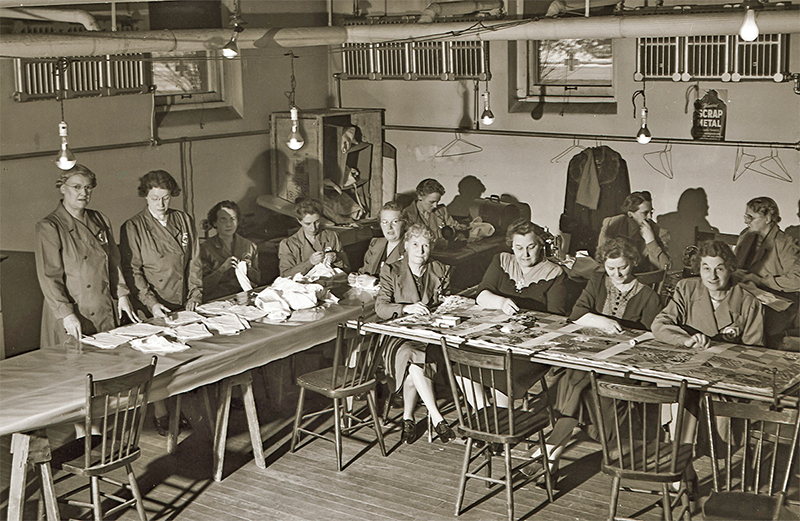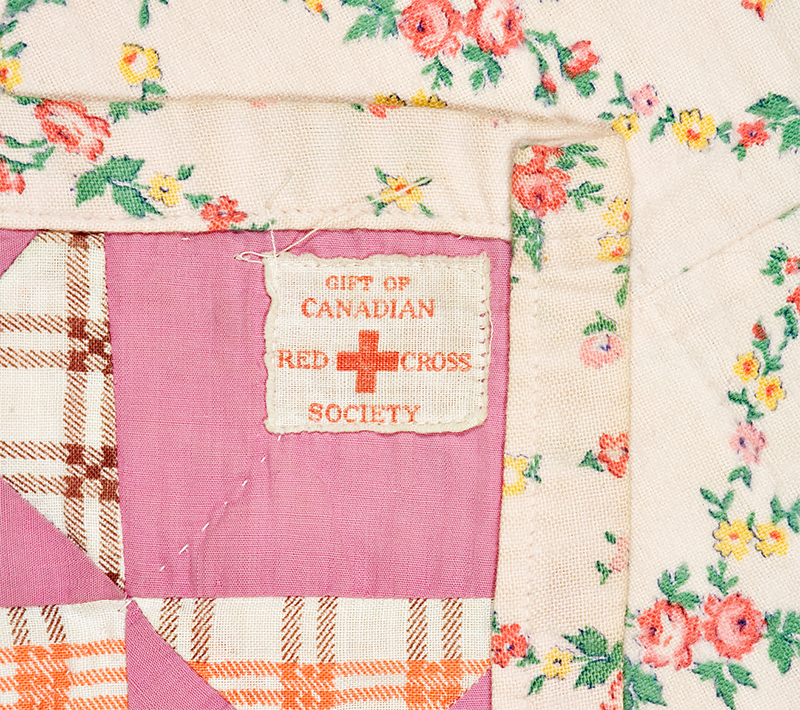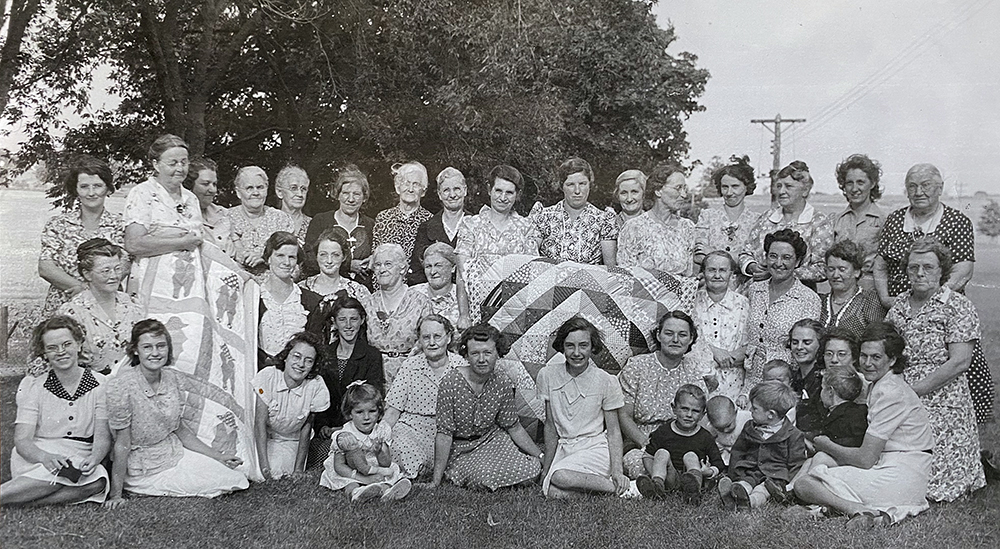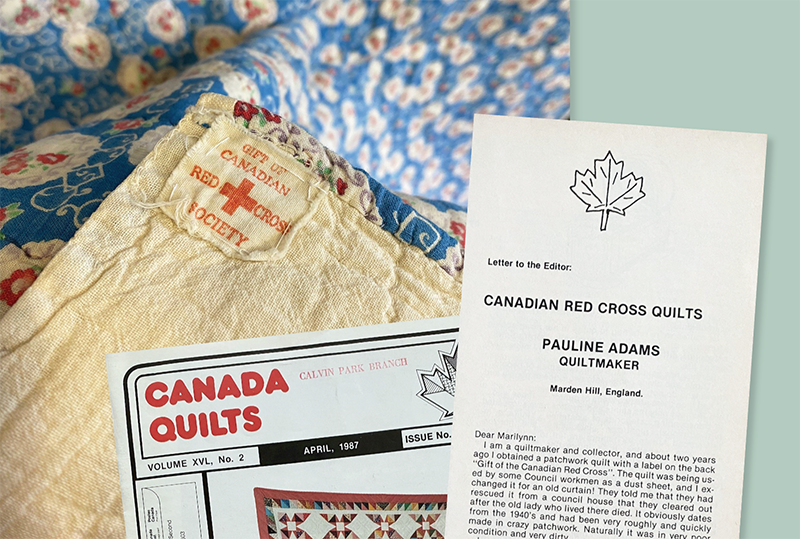The April 1987 issue of Canada Quilts published a letter to the editor from a British woman, Pauline Adams. She sought information about quilts made in Canada during the Second World War, that had been shipped to Britain.
Pauline wrote: “There seem to be a great many of these quilts in Britain, and I am now undertaking some research into the subject. it seems that some of your readers may have taken part in quilting bees or sewing circles making the quilts. If this is so, I would dearly love to hear from them, as a means of giving life to this little bit of quilting history.”
According to the Canadian Red Cross, our country shipped more than 52 million items to Britain during the war. Most of them were items sewn or knit voluntarily by women. Of these items, more than 400,000 quilts arrived for use in military barracks, hospitals, and for civilians who lost their homes in the bombing raids. Many of the quilts were identified with a tiny cloth label, “Gift of the Canadian Red Cross Society.”
The search begins
I don’t know what replies she received, but Pauline’s letter is the earliest example I have found that anyone researched and collected these quilts. Between 1987 and 2005, Isobel Holland, Bridget Long, and Sally Ward in Britain, and Chrilla Wendt in Germany continued and added to this research after locating unused quilts at a Munich market.
In 2005, three women—Dr. Anna Mansi, Maxine March, and Jackie Maxwell—decided to take on this research in earnest. Together, they formed the Canadian Red Cross Quilt Research Group (CRCQRG) as a sub-group of the British Quilt Study Group. They aimed to rescue as many Red Cross quilts as they could and form a joint collection. They also wanted to raise the profile of these quilts in both the quilting world and with the general public by giving talks to interested groups. Finally, they set out to find exhibition space for the collection and to collect stories of the makers and the recipients.

Women workers at the Red Cross Work Room in the basement of Hespeler Public Library, c. 1942. Credit Hespeler Heritage Centre. Photographer Frank Johnston.
From 2005 to 2020, these women researched, wrote, and presented lectures about the quilts they found and about how and where they were made. They meticulously recorded all the quilts they located in both public and private collections throughout Britain and in other parts of the world.
The inaugural exhibition
In 2010, the Quilters Guild of the British Isles mounted an exhibition of Canadian Red Cross quilts in York, England, with the assistance of the women of the CRCQRG. They showed quilts from both public and private collections, as well as their own. Another exhibition toured in 2016. Sadly, Anna Mansi passed away before the second exhibition, but her husband, Tony Mansi, continues to collect quilts in her memory and make presentations in England.
In 2022, Maxine March and Jackie Maxwell decided it was time to share the collected quilts with Canadians. Before 2020, as few as 10 of these quilts that returnedto public collections in Canadian museums. Combined, Maxine and Jackie had collected more than 60 quilts, and they hoped to find one interested museum in Canada for a permanent collection.
When no Canadian institutions would accept the whole collection, they enlisted Lucie Heins, Assistant Curator, Daily Life and Leisure, at the Royal Alberta Museum. She assisted them in finding permanent homes for individual quilts in museums across Canada. (Lucie will speak about the Red Cross quilts on Friday, June 21 at 1:30 pm during Quilt Canada 2024 in Edmonton.)

“Gift of Canadian Red Cross” label that identifies quilts that were made by volunteers in Canada and sent to the UK during the war.
Returning to Canada
Before quilts came back to Canada, the CRCQRG contacted British cultural institutions to inquire if any wished to add one or more quilts to their permanent collections. As a result, several more quilts remained within Britain. Then Lucie Heins contacted museums all across Canada, and through much organization and correspondence, placing 64 of these quilts in Canadian public collections. Quilts landed in almost every province, creating a tangible representation of the charitable wartime work of women.
Thank you to Maxine and David March, and to Jackie Maxwell for their foresight, for their diligent work in collecting and speaking about these quilts. The remaining few of the millions of gifts made and sent across the ocean by our mothers, aunts, grandmothers and great-grandmothers have now been gifted back to our nation. Now, we can learn about and honour the work of our foremothers. We would not have done this without the work of the CRCQRG.
SPECIAL NOTE During the repatriation project, wartime quilts did not get placed in museums in Quebec, though efforts were made. All quilts found homes before the Yukon, Nunavut, or Northwest Territories had offers. We expect, over time, that more surviving quilts may surface in Britain, that will come back to Canada. If you know of an institution that would be interested, ask them to contact the author to join a waiting list for a Canadian wartime quilt.
Many of these quilts exist in fair to poor condition after much use and love over the last 80 years. Few could withstand the rigours of a travelling exhibition.
Next steps
In the near future, I will seek funding to create an open-source public website to share multiple images and the written record of each quilt. Also, it will archive letters, articles and primary sources.
It is an ambitious project, but important for ongoing investigation into:
- the groups involved,
- their locations
- how they organized the work they undertook
- the materials used to make the quilts
- how they were sourced
- the methods used for quilt design and construction
- the role this making played in the lives of women on the home front
- the significance these quilts had to the recipients of these gifts during and after the war.
Society had ignored the unpaid wartime work of Canadian women for too long. The surviving quilts demonstrate this extraordinary effort. Further, they provide a window into all of the voluntary contributions of women on the home front in a period of cultural upheaval.
Most importantly, the quilts record the history of women’s lives. In the absence of written stories, articles about this work will document a vital story in Canada’s history and its international relationships in wartime.

West Arran Helpers, Ontario (later to become the West Arran Women’s Institute), c. 1942. Credit: Private collection—used by permission.
 Joanna Dermenjian is a quilter and a Research Associate at the Modern Literature and Culture Research Centre at Toronto Metropolitan University. She welcomes the opportunity to share her research about Canadian wartime quilts through presentations to quilt guilds and museums. You can read more about her research and see images of quilts on her website sutureandselvedge.com and on Instagram @suture_and_selvedge. She welcomes contributions to the conversation on the Facebook Group page Canada’s Forgotten Wartime Quilts.
Joanna Dermenjian is a quilter and a Research Associate at the Modern Literature and Culture Research Centre at Toronto Metropolitan University. She welcomes the opportunity to share her research about Canadian wartime quilts through presentations to quilt guilds and museums. You can read more about her research and see images of quilts on her website sutureandselvedge.com and on Instagram @suture_and_selvedge. She welcomes contributions to the conversation on the Facebook Group page Canada’s Forgotten Wartime Quilts.


